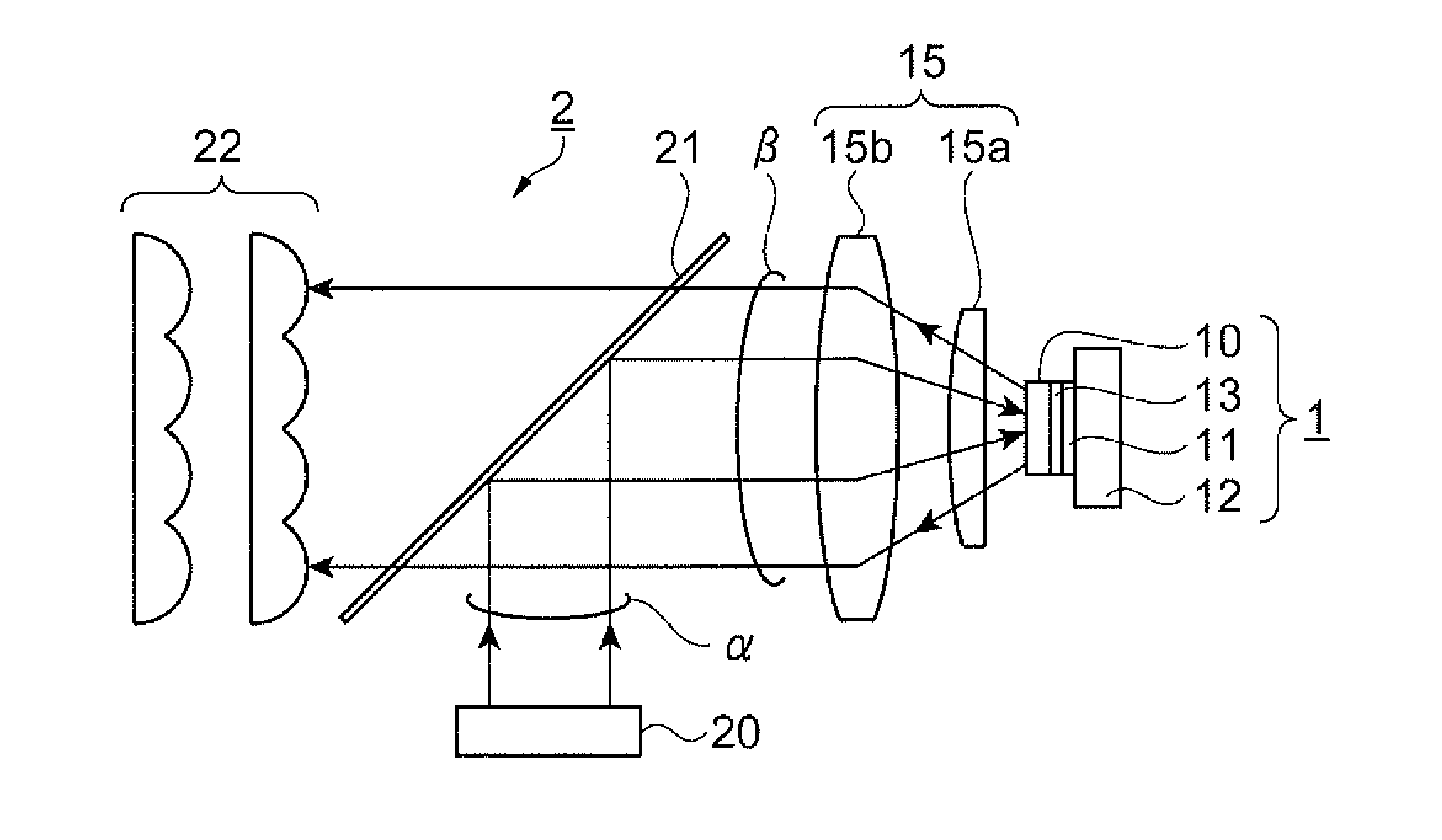Fluorescent light emitting element and projector
a technology of fluorescent light and projector, which is applied in the direction of lighting and heating equipment, instruments, optics, etc., can solve the problems of increasing phosphor, increasing phosphor, and increasing the heat resistance of the phosphor layer, so as to maximize light emission efficiency, improve the brightness of the fluorescent light emitting element, and achieve high output
- Summary
- Abstract
- Description
- Claims
- Application Information
AI Technical Summary
Benefits of technology
Problems solved by technology
Method used
Image
Examples
first embodiment
[0042
[0043]FIG. 1 is a view schematically illustrating an illuminating device 2 using a fluorescent light emitting element 1 according to a first embodiment. The configuration of the illuminating device 2 (fluorescent light emitting element 1) will be described with reference to FIG. 1.
[0044]Further, for convenience of the description, in order for the size of each member to be made recognizable, dimensions are differentiated from the actual dimensions and each member is appropriately enlarged or reduced for illustration in the following drawings including FIG. 1.
[0045]As illustrated in FIG. 1, the fluorescent light emitting element 1 includes a phosphor layer 10, a reflective film 11 constituting a reflection unit, a substrate 12, and an adhesive layer 13. Further, the illuminating device 2 includes a collimate optical system 15, an excitation light source 20, a dichroic mirror 21, and a lens array 22 in addition to the fluorescent light emitting element 1.
[0046]The phosphor layer ...
second embodiment
[0099
[0100]FIGS. 6A and 6B are views illustrating a configuration of a fluorescent light emitting element 1A according to a second embodiment. FIG. 6A is a plan view illustrating the fluorescent light emitting element 1A and FIG. 6B is a cross-sectional view illustrating the fluorescent light emitting element 1A. The configuration and an operation of the fluorescent light emitting element 1A will be described with reference to FIGS. 6A and 6B.
[0101]As illustrated in FIGS. 6A and 6B, the fluorescent light emitting element 1A of the present embodiment is formed of a wheel substrate 12A as a substrate, a phosphor layer 10A, a reflective film 11A, and an adhesive layer 13A. The wheel substrate 12A is a plate-like substrate formed in an approximately circle shape in a plan view with a predetermined rotation axis A as the center and is rotatable around the rotation axis A.
[0102]The phosphor layer 10A is formed to be extended along the rotation direction of the wheel substrate 12A. Moreove...
third embodiment
[0123
[0124]FIG. 8 is a cross-sectional view illustrating a configuration of a fluorescent light emitting element 1B according to a third embodiment. The configuration and an operation of the fluorescent light emitting element 1B will be described with reference to FIG. 8.
[0125]As illustrated in FIG. 8, the fluorescent light emitting element 1B of the present embodiment has a different position of a reflective film 11B from that of the fluorescent light emitting element 1 of the first embodiment. Further, accompanied by this, the position and the configuration of an adhesive layer 13B are different from those of the fluorescent light emitting element 1 of the first embodiment.
[0126]While the reflective film 11 (FIG. 2) of the first embodiment is provided between the adhesive layer 13 and the substrate 12, the reflective film 11B of the present embodiment is provided between the adhesive layer 13B and the phosphor layer 10B as illustrated in FIG. 8.
[0127]The phosphor layer 10B has the...
PUM
 Login to View More
Login to View More Abstract
Description
Claims
Application Information
 Login to View More
Login to View More - R&D
- Intellectual Property
- Life Sciences
- Materials
- Tech Scout
- Unparalleled Data Quality
- Higher Quality Content
- 60% Fewer Hallucinations
Browse by: Latest US Patents, China's latest patents, Technical Efficacy Thesaurus, Application Domain, Technology Topic, Popular Technical Reports.
© 2025 PatSnap. All rights reserved.Legal|Privacy policy|Modern Slavery Act Transparency Statement|Sitemap|About US| Contact US: help@patsnap.com



